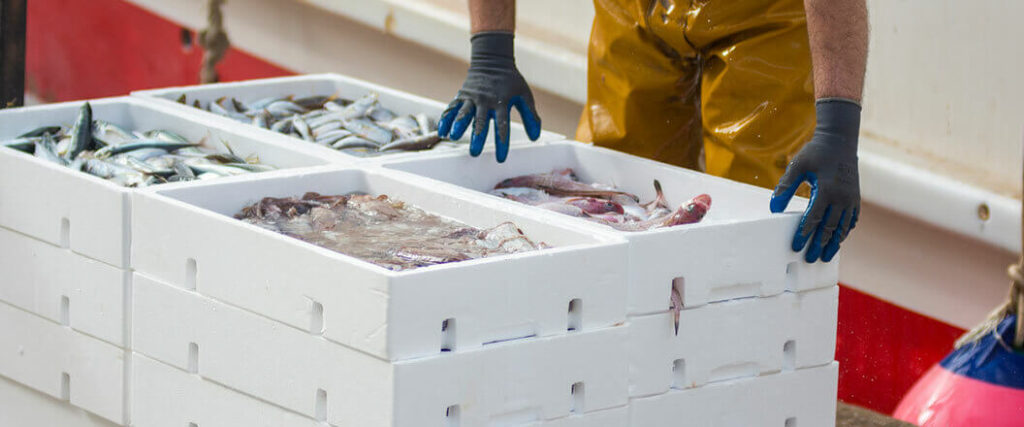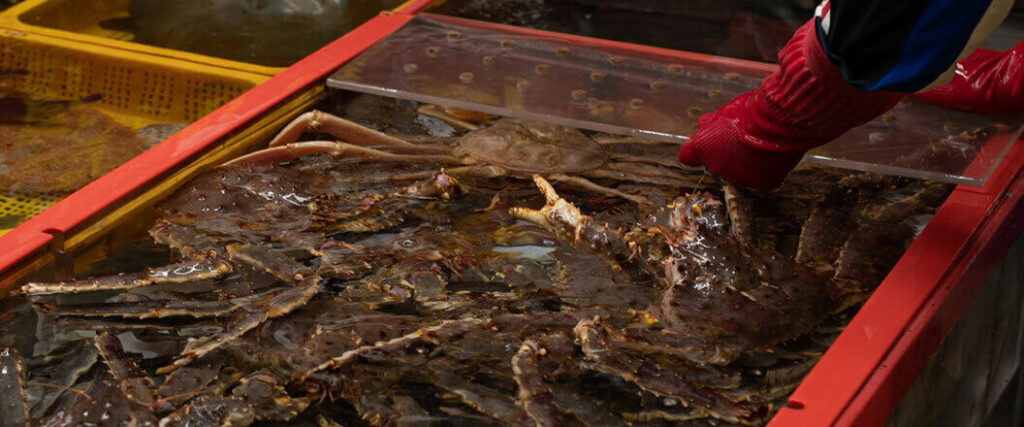How to ship seafood: for those in the seafood business, this is an important question. Boxing up your catch and loading your truck isn’t enough to get the job done. Shipping cold items such as seafood requires specialized vehicles with temperature-controlled trailers. A few degrees off, and your lucrative shipment can spoil within minutes.
According to the National Fisheries Institute, shipping seafood demands precision and expertise. Ensuring the catch remains fresh or properly frozen during transit is key. Food shipment involves careful temperature regulation, using specialized refrigerated freight services, and adhering to strict packaging protocols.
In this article, you’ll learn the best practices of seafood shipping. From frozen fish to live crabs, we’ll show you how to ship food from the sea safely and at peak freshness.

Shipping food of any kind poses challenges not found with inedible cargo. For fresh, frozen, and live seafood, those challenges only increase.
Shipping seafood requires processes and equipment that other foods don’t. The quality of your seafood cargo during its voyage is paramount. Whether it's fresh salmon or frozen shrimp, perishable shipments require carefully controlled shipping environments.
Maintaining freshness is key to ensuring the delivery of high quality seafood. This isn't just about taste; it's about health and safety. Seafood that isn't handled correctly can play host to various bacteria, leading to health risks for consumers.
Read our article on how to ship fresh produce if you want to move fruits and vegetables.
To ship fresh fish, you’ll need to maintain a specific temperature range and get your shipment to its destination quickly. Let’s look at some specifics of shipping fresh, unfrozen seafood.
Fresh seafood is a perishable product that requires careful shipping to ensure it arrives in edible condition. When shipping fresh fish, you'll want to follow a few crucial steps:
Temperature is worth exploring further. A few degrees difference can have a dramatic effect on the quality and edibility of seafood.
For example, perhaps you want to know how to ship fresh fish and ensure it holds its quality for the maximum amount of time. That way, your customers will be less likely to waste food and more likely to order in bulk.
Let’s take a look at how long a fish filet stays fresh from 29 to 42 degrees Fahrenheit.
| Holding Temperature (°F) | High Quality Shelf Life | Edible Shelf Life |
| 29 | 12 days | 20 days |
| 30 | 10 days | 17 days |
| 32 | 8 days | 14 days |
| 42 | 3 days | 6 days |
Source: noaa.gov
As you can see, the two-degree difference between 30 and 32 leads to a 17-percent reduction in edible shelf life.
Shellfish are, well, a whole other kettle of fish. In this case, fresh usually means shipping live seafood. Different types of shellfish require different temperatures to maintain freshness in transit, as show below.
| Type of Shellfish | Shipping Temperature (°F) |
| Crustaceans | 36-38 |
| Mollusks | 41-45 or lower |
We can see that some different types of seafood can be shipped together at one temperature. However, live crustaceans, such as lobsters, have a narrow optimal temperature range.
In essence, shipping fresh seafood is about minimizing the time it's out of its natural environment while ensuring it's always at the right temperature. Properly packed and swiftly shipped seafood will result in a delicious experience for the end consumer.

Shipping frozen fish and other seafood requires careful attention to temperatures and hygiene. The product must retain its quality and flavor without spoiling. While frozen seafood has a longer shelf life compared to fresh, it comes with its unique set of challenges. Understanding and overcoming these hurdles is crucial to delivering seafood in its best condition.
Challenges in shipping frozen seafood include:
By addressing the inherent challenges of shipping perishables at freezing temperatures, shippers can guarantee the delivery of premium-quality frozen seafood every time.
Frozen seafood requires a different set of considerations than its fresh counterpart. Keeping it frozen throughout its journey is paramount to maintaining its quality, taste, and texture.
When relying on refrigerated freight for shipping, here are some best practices to ensure your frozen seafood reaches its destination in optimal condition:
When shipping frozen seafood, the primary goal is to preserve its frozen state from point A to B.
By following these best practices and partnering with a reliable refrigerated freight provider, you'll ensure that the seafood remains in the finest condition during transit.

When it comes to packaging, a few essentials work for both fresh and frozen seafood.
There are also requirements that vary based on the type of seafood you’re shipping, including packaging strategies and temperatures.
The world of seafood is vast and varied, and so are its shipping requirements. Different types of seafood possess unique characteristics that need particular attention during transport.
Let's look closely into the requirements for the two most common categories: shellfish and finfish. To clarify, finfish literally refers to fish with fins. It’s really just to clarify that the product being shipped isn’t shellfish.
In either case, they both require:
While both shellfish and finfish require cold environments, the specifics of their packaging and handling can differ. Recognizing these nuances is key to ensuring they reach their destination at peak quality.

If you need to transport seafood in bulk, you will most likely need a refrigerated truck. Temperature control is the most important aspect of seafood transport. Without it, seafood can’t travel far without spoiling.
Let’s take a more in-depth look at how refrigerated trucks are key to shipping fresh and frozen seafood.
In the world of perishable goods, especially seafood, the transportation mode can be the difference between a fresh, quality product and a ruined shipment. Refrigerated trucks and frozen food couriers are an absolute necessity.
The main challenge in transporting perishables is keeping temperatures stable. Refrigerated trucks are specifically designed for this, with:
Refrigerated trucks also feature advanced sanitation thanks to:
Refrigerated trucks and frozen food couriers are the backbone of cold chain logistics. They ensure that quality, safety, and freshness are maintained from the point of origin right to the customer’s door. Without them, shipping fresh seafood would be practically impossible.
Shipping large amounts of seafood poses plenty of logistical hurdles. However, partnering with experts in cold chain logistics can reduce difficulties and lead to smooth sailing for seafood shippers. If your business needs a reliable frozen food shipping service, we’ve got you covered.
At USA Refrigerated Freight, you’ll find experienced professionals in logistics with the right equipment for transporting fresh and frozen goods, including:
Don’t let uncertainties about shipping fresh and frozen seafood spoil your business plans. Contact the experts at USA Refrigerated Freight at (866) 849-2713 or request a quote online today.
Whether you’re sending salmon, hauling haddock, or shipping shrimp, we’re here to help.
USA Refrigerated Freight
315 NE 14th Street #4122
Ocala, FL 34470
Hi I'm enquiring to send some crayfish and paua to tauranga can you please advise me how to do so